Valtra is an agricultural machinery manufacturer based in Äänekoski, Finland. Valtra's products include tractors, combine harvesters, sugar cane harvesters, self-propelled sprayers and seed drills. Valtra has been part of the American AGCO Corporation since 2004.

Oy Sisu Auto Ab is a truck manufacturer based in Raseborg, Finland. Its name comes from the Finnish word sisu meaning guts, grit and determination.

The Sisu RA-140 DS "Raisu" is a flail-type demining vehicle developed and produced by the Finnish company Sisu-Auto and later produced by Patria Vehicles in the years 1994–2001. The production totalled 41 units.
The Patria Pasi is a military armoured personnel carrier. It was the choice of the Finnish Defence Forces to replace its aging Soviet BTR-60s. It was a result of the commercial competition between two Finnish companies, a tractor manufacturer Valmet and the lorry manufacturer Sisu, which won the contract with its prototype.

Sisu SA-150 is a medium-size, two-axle off-road lorry made by the Finnish heavy vehicle manufacturer Oy Sisu-Auto Ab from 1982 until 1991. The four-wheel-drive lorry with load capacity of 6,400 kg was developed for pulling of heavy cannons of the Finnish Defence Forces.
Sisu SA-110 is a prototype of a light two-axle off-road lorry made by the Finnish heavy vehicle manufacturer Oy Sisu-Auto Ab in 1986. Total six pieces were made. The vehicle was partly armoured.

Vanajan Autotehdas Oy (VAT) was a producer of heavy vehicles based in Hämeenlinna, Finland. The company was founded as Yhteissisu Oy in 1943 by the Finnish government and a number of major Finnish companies with the aim of producing lorries and buses for the Finnish Defence Forces. World War II was over before the company could start series production; it was renamed Vanajan Autotehdas and the marque became Vanaja. Subsequently, the production consisted of outdated lorry models, partly built from military surplus materials. After overcoming initial difficulties, the company modernised its products, became profitable and grew until the mid-1950s. Many major components, including engines, were imported. Diesel engines became widely available in 1955, and in 1959 VAT introduced its most significant innovation, the full load lifting tandem axle mechanism, which improved off-road capability significantly; the system is now used in Sisu vehicles.

Sisu SA-240 is a heavy off-road lorry made by the Finnish heavy vehicle manufacturer Oy Sisu-Auto Ab from 1984 until 1991. The six-wheel drive lorry with payload of 12,000 kg was developed for pulling of heavy cannons of the Finnish Defence Forces.
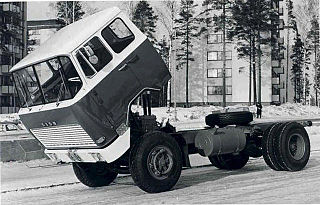
Sisu KB-112 is a three-axle lorry made by the Finnish heavy vehicle manufacturer Suomen Autoteollisuus (SAT) from 1962 though 1969. The vehicle was equipped with a technically advanced tiltable cabin. A two-axle variant, the KB-117, was produced from 1964 through 1969. Both versions were only produced in small numbers.

Sisu A-45 is a light off-road lorry made by the Finnish heavy vehicle producer Suomen Autoteollisuus (SAT) in 1970–1982. The two-axle, all-wheel-drive vehicle with payload of 4 150 kg was a further development of Sisu KB-45, that was originally developed after an assignment of the Finnish Defence Forces.
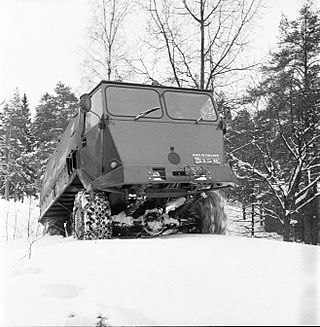
Sisu KB-45 is a light off-road lorry made by the Finnish heavy vehicle producer Suomen Autoteollisuus (SAT) in 1965–1970. The two-axle, all-wheel-drive vehicle with payload of 4,000 kg was developed after an assignment of the Finnish Defence Forces. It was followed by almost identical A-45/AH-45 in 1970.
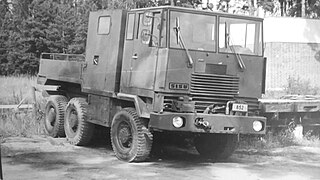
Sisu KB-46 is a prototype of a three-axle, six-wheel-driven off-road lorry made by the Finnish heavy vehicle producer Suomen Autoteollisuus (SAT) in 1968. Its capacity is three tonnes and it was produced after an assignment of the Finnish Defence Forces to tow heavy cannons.

Sisu K-44 is a three-axle 4×4+2 driven lorry made by the Finnish heavy vehicle manufacturer Suomen Autoteollisuus (SAT) from 1959 to 1965. The most usual applications were for log transportation and earth moving vehicles. The K-44 was noted for its excellent gradient capabilities. The legally permissible maximum vehicle payload was between 7 800 and 11 750 kg: with a trailer this increased to 20 000 kg. The K-44s were powered by Leyland diesel engines with power outputs of between 85.8 and 156.7 kW.

Sisu K-50SS is a six-wheel-driven ballast tractor made by the Finnish heavy vehicle producer Suomen Autoteollisuus (SAT). The vehicle can generate a 388 kN drawing force and it was used for pulling flatbed trailers.

Sisu Polar is a truck model series produced by the Finnish heavy vehicle producer Sisu Auto. It came into the market in 2011 and the main applications are earthmovers, logging trucks, road maintenance vehicles, mobile cranes and heavy machinery hauliers which are fully equipped in the factory. The series includes two main variants DK12M and DK16M. The number of axles is 3, 4 or 5. Mercedes-Benz supplies some key components; cabins and engines in particular.

Sisu M-series is a 2–4-axle forward control lorry model series made by the Finnish heavy vehicle producer Suomen Autoteollisuus (SAT) in 1969–1984. The series consists of 4×2-driven M-161, 6×2-driven M-162, 6×4-driven M-163 and 8×2-driven M-168. Typical applications were logging trucks, tankers and long-distance transportation haulers which pulled conventional and semi-trailers. The permissible payloads varied from ca. 9 tonnes up over 18 tonnes.
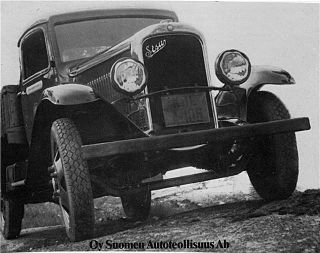
Sisu S-321, S-322 and S-323 is the first lorry and bus model series made by the Finnish heavy vehicle producer Suomen Autoteollisuus (SAT) in 1932–1934. Upgraded models S-341 and S-342 were produced in 1934. The vehicles were heavily based on Volvo components. The two-axle, 4×2-driven lorries were designated with 2,500 kg capacity and total weight of 4,800 kg.
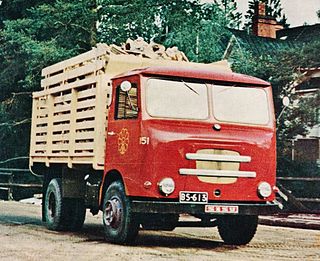
Sisu KB-24 is a two-axle lorry and special vehicle chassis made by the Finnish heavy vehicle manufacturer Suomen Autoteollisuus (SAT) from 1955 to 1960. It is a six-tonne delivery lorry planned to operate on narrow streets in Finnish cities.

Sisu R-series is a 2–3-axle lorry model series made by the Finnish heavy vehicle producer Suomen Autoteollisuus (SAT) in 1970–1982. The series consists of 4×2-driven R-141 and R-148, 6×2-driven R-142, 6×4-driven R-143 and R-149, 4×4-driven R-144, 4×4+2-driven R-145 and 6×6-driven R-146. Typical applications are logging trucks, dumper trucks and long-distance transportation haulers which pull conventional and semi-trailers.
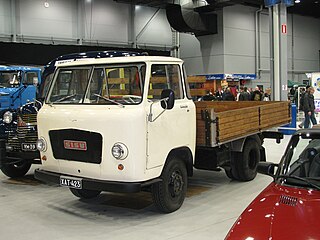
Sisu KB-124 was a two-axle lorry and special vehicle chassis made by the Finnish heavy vehicle manufacturer Suomen Autoteollisuus (SAT). It was a six-tonne delivery lorry which was developed to follow the KB-24. The KB-124 was produced from 1961 until 1968, when it was replaced by the similar KB-121 with increased permitted load. Production ceased in about 1972.

















